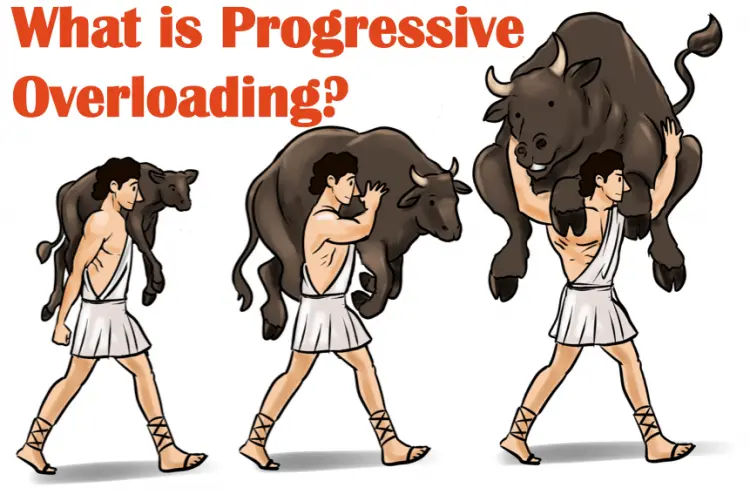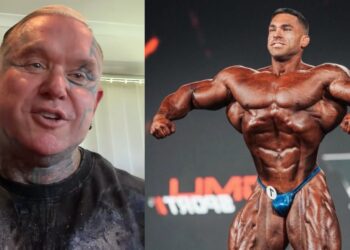Building muscle is one of the most satisfying endeavors.
However, resistance training comes with a steep learning curve. You cannot expect to lift weight with the perfect form and pack on muscle mass from your very first workout. As a personal trainer with over seven years of hands-on experience, I have helped hundreds of people transform their physiques (and witnessed thousands struggling in their pursuits).
Time and again, I see people making the same mistakes, which not only lead to suboptimal results but also significantly increase injury risk.
In this article, I will take you over the 10 most common bodybuilding mistakes everyone makes. We will also delve into how you can work around these errors to fast-track your progress.
Mistake #1: Lack of Progressive Overload
Progressive overload is the name of the game when it comes to building muscle consistently.
Incorporating progressive overload in your workouts involves gradually increasing the load on your muscles. It could be achieved by lifting heavier weights, doing more sets and reps, reducing the rest time between sets, or using advanced training principles like dropsets, supersets, and intraset stretching. (1)
Level Up Your Fitness: Join our 💪 strong community in Fitness Volt Newsletter. Get daily inspiration, expert-backed workouts, nutrition tips, the latest in strength sports, and the support you need to reach your goals. Subscribe for free!
Programming progressive overload into your workouts ensures your body doesn’t adapt to your training regimen.
Lifting the same weight for an extended period can lead to strength and muscle plateaus as your muscles get used to the stimulus and stop responding. You must always aim to avoid a plateau, as breaking through one can take a long time.
Remember, you shouldn’t compromise your training form while trying to overload your muscles. Your safety should be your first priority. Attempting a 1RM or PR with a spotter significantly lowers the risk of injury.
I highly recommend beginners hire a personal trainer to implement progressive overload into their workouts. A personal trainer can also help you learn the correct exercise movement mechanics, which is a key factor in promoting hypertrophy.
Mistake #2: Improper Form
Improper form is a silent killer of your gains.
Training with an improper form is like driving with a flat tire. You might be moving in the right direction, but the progress is usually slow and dangerous. Instead, you should invest the time to get out of the car and replace the tire before continuing the journey.
Training with an incorrect form leads to suboptimal results and shoots up your risk of injury.
A sloppy form prevents you from fully engaging the target muscle during an exercise. Plus, it puts unnecessary strain on the joints, ligaments, and tendons.
Although you must watch your form while performing every exercise, you should be extra careful during compound exercises, as they involve several moving parts. Beginners should perform multi-joint movements like squats, deadlifts, and bench presses under expert guidance.
Watch YouTube videos by expert lifters and coaches to drill the correct exercise technique.
Beginners who train alone should focus primarily on machine isolation exercises, as they can help master the right movement mechanics. You can then move on to cable exercises before transitioning to free-weight exercises.
Pro Tip: Record yourself performing an exercise to ensure you are using the right technique. Use slow-motion playback for a better analysis.
Mistake #3: Neglecting Sleep and Recovery
Contrary to what most people think, you don’t build muscle during a workout.
Your muscle tissues break down while you’re lifting weights. They grow back bigger and stronger while you’re resting. Overlooking rest, especially sleep, can hamper your overall gains.
You must sleep for at least seven to eight hours each night to give your body enough time to recover.
Your body undergoes hormonal changes while you’re asleep. Short sleep can hamper ghrelin and leptin levels, the two appetite hormones that manage your hunger. Furthermore, deep sleep triggers the release of growth hormone and testosterone, which can help pack on muscle mass.
A study found that men with shorter sleep duration (less than six hours) had poorer muscle strength than men who slept for seven or eight hours and over eight hours. (2)
It doesn’t end here. When you are sleep-deprived, it can hamper your mental focus and physical performance.
Get in the habit of hitting the sack at the same time every day. A regular schedule can help regulate your body’s internal clock. Plus, establishing a bedtime routine can prime you for deep sleep.
Pro Tip: Recovery shouldn’t end with seven to eight hours of sleep. Incorporate active rest days, massages, and self-myofascial release (foam rolling) into your regimen for optimal recovery.
Mistake #4: Inconsistent Nutrition
Following an inconsistent nutrition plan is one of the biggest bodybuilding mistakes everyone makes.
While protein is the darling of the bodybuilding community, there is more to a balanced diet than eating chicken breasts for lunch and fish for dinner. You must follow a balanced nutrition program to optimize muscle growth.
Here are the three macronutrients and their roles:
- Protein: It is the building block of muscle and is essential for muscle tissue repair and growth. Folks trying to build muscle should aim for 1 gram of protein per pound of body weight. (3)
- Carbohydrates: Carbs are the body’s primary source of energy. The body stores excess carbs in the form of glycogen in the body. You should prioritize complex carbs like brown rice and sweet potatoes for sustained energy.
- Fats: Healthy fats support hormone production, which is crucial for muscle growth. Plus, it is essential for brain function and heart health. Some quality fat sources include nuts, seeds, fatty fish, and avocados.
An inconsistent nutrition program can lead to spikes and crashes in energy levels, hampering your performance and recovery.
More importantly, you should avoid fad diets as they can lead to nutrient deficiencies and eating disorders.
Work with a certified nutritionist to determine your ideal daily calorie and macronutrient intake and break it into three or four healthy meals. A sustainable diet that fits your lifestyle reduces your risk of binging on junk food.
Mistake #5: Training Without a Plan
You don’t build a chiseled physique by performing a few random exercises in the gym.
If you’re hitting the gym without a structured training plan, you’re doing nothing more than wasting your time. Working out without a goal-oriented plan might help you burn a few calories, but it isn’t very effective for building muscle and fixing strength and muscle imbalances.
The exercises, sets, reps, and weights in your workout program should help you work toward your bodybuilding goals.
A structured program ensures that you are delivering the right amount of stimulus required to promote hypertrophy and strength gains. It also involves cycling your training intensity and volume to avoid overtraining.
Level Up Your Fitness: Join our 💪 strong community in Fitness Volt Newsletter. Get daily inspiration, expert-backed workouts, nutrition tips, the latest in strength sports, and the support you need to reach your goals. Subscribe for free!
Are you looking for a workout program for beginners? This four-week routine will help you build a solid foundation.
ATHLEAN-X’s Take on How an Incorrect Training Plan Can Affect Your Health
Besides following a structured training plan that trains your entire body, you must also ensure the exercises in your training regime suit your biomechanics.
Performing exercises that go against your body structure can hurt your overall health and fitness. Here is what Jeff Cavaliere (MSPT, CSCS) of the ATHLEAN-X fame had to say on the subject in a YouTube video:
“I made many mistakes when it comes to performing exercises I probably should not have. Years of damage were done in a short period of time by performing strength-based exercises without properly addressing my flat feet. The poor biomechanics and form on the exercises led to a quick breakdown of my knees, which still plague me to this day.” — Jeff Cavaliere
Mistake #6: Skipping Legs
It’s no secret that leg training is despised by a major chunk of lifters.
Your legs house some of the largest muscles in the body, including quads, glutes, and calves. Lower body compound exercises like squats and Romanian deadlifts can also help boost growth hormone and testosterone production, which can promote overall hypertrophy.
Skipping leg training can hamper your overall physique aesthetics, functionality, and strength.
Since you are effectively training half of your body on a leg day, they usually burn more calories compared to arm or shoulder workouts. Leg workouts can lead to EPOC (Excess Post-Exercise Oxygen Consumption), which increases oxygen intake and metabolism after strenuous activity.
EPOC can help burn more calories throughout the day, even when you are not physically active.
Strong legs also act as a strong foundation, which can supercharge your workouts. It can also lead to a strong core and spine, which can be vital for preventing injuries and pain.
Mistake #7: Ignoring Mind-Muscle Connection
Every day, I see people at the gym going through the motions for the sake of it.
To build muscle tissue, you must develop a robust mind-muscle connection. It amplifies the target muscle stretch and contraction and maximizes stimulation. A mind-muscle connection establishes a strong neural link, maximizing the work and minimizing wasted effort.
Working on developing a mind-muscle connection can also help improve your form, as it makes the exercises more deliberate.
Many of my personal training clients report that they have to lift relatively lighter weights to achieve peak target muscle contraction and maintain constant tension throughout the range of motion (ROM).
While you are at it, you must also practice visualization, which is pioneered by the seven-time Mr. Olympia champion, Arnold Schwarzenegger.
Visualization involves imagining what you want your muscles to look like before, during, and after a set. For instance, Schwarzenegger imagined his biceps turning into mountain peaks while performing bicep curls.
Pro Tip: Slowing down the eccentrics and holding the isometric contraction can improve your mind-muscle connection.
Mistake #8: Overtraining
More is not always better, especially when it comes to lifting weights.
You must push yourself to build muscle; however, pushing yourself too hard can increase your risk of injury. When you lift weights, you develop micro tears in the muscle fibers. The muscle tissues repair and grow bigger and stronger while you are resting.
Not allowing enough recovery time between high-intensity training sessions combined with other training and non-training stressors can lead to overtraining. (4)
Overtraining increases your risk of injury and can keep you out of the gym for a long time.
Here are the some of the signs and symptoms of overtraining:
- Persistent Soreness: DOMS after an intense training session is expected. However, you should seek medical help if the soreness doesn’t ease up after a few days.
- Decreased Performance: Overtraining can hamper physical performance to the point that you might struggle to lift your usual weights.
- Mood Fluctuations: Overtraining can lead to exhaustion, which can negatively impact your mood and cause persistent irritability. A loss of motivation and feelings of depression are other red flags you must look out for.
- Sleep Issues: Constant stress might cause trouble going to sleep, or you might feel exhausted on waking up.
Irrespective of your training objective, you must give your body at least one full rest day per week to limit the risk of overtraining. You should also lower your training intensity by about 50 percent every four to six weeks to avoid burnout. This is known as a deload week in bodybuilding.
Mistake #9: Ego Lifting
Ego lifting is one of the most common bodybuilding mistakes everyone makes.
Here is a wake-up call for advanced lifters: To build muscle and strength, you need to lift much less weight than you think. Pulling a deadlift PR once in a while is absolutely fine, but you don’t need to push yourself to the limit in each workout (unless you’re training for a competition).
According to a study published in the Sports Journal, you should perform a moderate repetition scheme with moderate loads (from eight to 12 repetitions per set with 60 to 80 percent of 1RM) to optimize hypertrophy. (5)
Instead of killing yourself on a heavy set, aim to lift a moderate amount of weight with proper form for the recommended reps (eight to 12). Prioritize optimal muscle contraction and stretch to maximize muscle stimulation.
Controlled lifting will also help you drill the movement mechanics, which can help you lift progressively heavier weights with the proper form.
Mistake #10: Reliance on Supplements over Real Food
Nutrient-dense whole foods should be your go-to for meeting your daily macro and micronutrient goals.
Sports supplements are incredible tools. However, they must only be used to plug the gaps in your whole-food diet. You should never substitute real food with powders and pills. There is a reason why they are called supplements; they are meant to supplement and not replace real food.
Here is a list of foods that can be a part of your fitness regimen:
- Whey Protein: A quick-absorbing supplement that supplies the much-needed protein to your muscles after a training session. You can also consume it during the day if you can’t meet your daily protein needs through food alone.
- Creatine: One of the most researched supplements that has been shown to boost strength and power output. It can also boost muscle growth.
- BCAAs: It can be used as an intra-workout supplement to kickstart the recovery process during the training session.
- Multivitamins: Ensures you don’t run into any micronutrient deficiencies.
Some of the supplements that I advise against include fat burners, pre-workout supplements, and any ‘newest, most cutting-edge supplements.’ Most of the supplements that work have been around for ages.
Stick with what works and avoid spending your hard-earned dollars on marketing hype.
Conclusion
Building a Greek god physique requires a mix of dedication, patience, persistence, careful planning, and learning from your mistakes. You must always be mindful (and aware) of your fitness routine and be open and willing to make changes when and where necessary.
Now that you know the 10 most common bodybuilding mistakes everyone makes, you must analyze your own routine to steer clear of them. People having trouble mending the errors on their own should seek a personal trainer’s intervention.
If you have any questions about building muscle, let me know in the comments below, and I’ll be happy to help!
References
- Krzysztofik M, Wilk M, Wojdała G, Gołaś A. Maximizing Muscle Hypertrophy: A Systematic Review of Advanced Resistance Training Techniques and Methods. Int J Environ Res Public Health. 2019;16(24):4897. Published 2019 Dec 4. doi:10.3390/ijerph16244897
- Chen Y, Cui Y, Chen S, Wu Z. Relationship between sleep and muscle strength among Chinese university students: a cross-sectional study. J Musculoskelet Neuronal Interact. 2017;17(4):327-333.
- Morton, R. W., Murphy, K. T., McKellar, S. R., Schoenfeld, B. J., Henselmans, M., Helms, E., Aragon, A. A., Devries, M. C., Banfield, L., Krieger, J. W., & Phillips, S. M. (2018). A systematic review, meta-analysis, and meta-regression of the effect of protein supplementation on resistance training-induced gains in muscle mass and strength in healthy adults. British journal of sports medicine, 52(6), 376–384. https://doi.org/10.1136/bjsports-2017-097608
- Fry, R. W., Morton, A. R., & Keast, D. (1991). Overtraining in athletes. An update. Sports medicine (Auckland, N.Z.), 12(1), 32–65. https://doi.org/10.2165/00007256-199112010-00004
- Schoenfeld BJ, Grgic J, Van Every DW, Plotkin DL. Loading Recommendations for Muscle Strength, Hypertrophy, and Local Endurance: A Re-Examination of the Repetition Continuum. Sports (Basel). 2021;9(2):32. Published 2021 Feb 22. doi:10.3390/sports9020032













